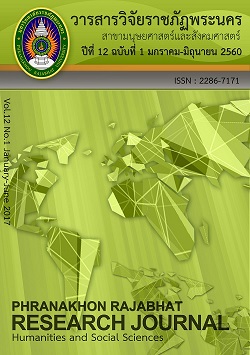รูปแบบการจัดการการผลิตไฟฟ้าด้วยกังหันลมของหน่วยงานราชการ
Main Article Content
Abstract
การวิจัยครั้งนี้มีวัตถุประสงค์ เพื่อศึกษาขั้นตอนการจัดตั้งโครงการการผลิตไฟฟ้าด้วยกังหันลมตามหลักวิชาการ บริบทการจัดการ ปัจจัยที่มีผลต่อการจัดการ และ เพื่อสร้างรูปแบบการจัดการการผลิตไฟฟ้าด้วยกังหันลมของหน่วยงานราชการที่มีประสิทธิผล เป็นการวิจัยเชิงคุณภาพ โดยการเก็บข้อมูล จากผู้แทนของหน่วยงานราชการที่ติดตั้งกังหันลมผลิตไฟฟ้า ผู้แทนของนักวิชาการที่มีผลงานการศึกษา วิจัยและพัฒนากังหันลมผลิตไฟฟ้า และ ผู้แทนของวิศวกรผู้ที่มีประสบการณ์ในการติดตั้งกังหันลมผลิตไฟฟ้าให้กับหน่วยราชการ ด้วยการสัมภาษณ์เชิงลึก จำนวน 33 คน และการสังเกตแบบไม่มีส่วนร่วม จำนวน 15 พื้นที่ นำข้อมูลที่ได้มาวิเคราะห์ข้อมูลด้วยการตีความ
ผลการวิจัยพบว่า
1. ขั้นตอนการจัดตั้งโครงการการผลิตไฟฟ้าด้วยกังหันลมตามหลักวิชาการ ต้องดำเนินการตามขั้นตอนของการทำโครงการ จำนวน 2 ขั้นตอน (1) การศึกษาความคุ้มค่าทางด้านเศรษฐศาสตร์ และ (2) การดำเนินโครงการ เมื่อพบว่าพื้นที่เป้าหมายมีศักยภาพที่มีความคุ้มค่าทางด้านเศรษฐศาสตร์
2. บริบทการจัดการการผลิตไฟฟ้าด้วยกังหันลมของหน่วยงานราชการ มี 2 ประเภท คือ โครงการที่สามารถดำเนินการผลิตไฟฟ้าได้อย่างต่อเนื่อง และ โครงการที่ไม่สามารถดำเนินการผลิตไฟฟ้าได้อย่างต่อเนื่อง โดยโครงการที่สามารถดำเนินการผลิตไฟฟ้าได้อย่างต่อเนื่อง เพราะว่ามีการวางแผนการทำโครงการอย่างเป็นระบบอย่างเป็นขั้นตอน เริ่มจากการวางแผนการทำโครงการด้วยการศึกษาศักยภาพของพื้นที่อย่างน้อย 1 ปี ควบคู่กับการศึกษาด้านเทคนิคของกังหันลมผลิตไฟฟ้าที่มีขายในท้องตลาด จากนั้นต้องกำหนดแนวทางจัดการของหน่วยงานราชการที่เกี่ยวข้องเพื่อแบ่งปันความรับผิดชอบก่อนของบฯ โดยจะมีรายละเอียดของแผน คน เงิน วัสดุอุปกรณ์ และเครื่องมือเครื่องจักร ส่วนโครงการที่ไม่สามารถดำเนินการผลิตไฟฟ้าได้อย่างต่อเนื่อง เพราะว่าไม่มีการวางแผนการทำโครงการอย่างเป็นระบบอย่างเป็นขั้นตอนหรือมีการวางแผนแต่ไม่ได้ดำเนินการในแต่ละขั้นตอนอย่างเคร่งครัด
3. ปัจจัยที่มีผลต่อการจัดการการผลิตไฟฟ้าด้วยกังหันลมของหน่วยงานราชการ ประกอบด้วย 5 ปัจจัย ประกอบด้วย คน เงิน วัสดุอุปกรณ์ เครื่องมือเครื่องจักร และ การมีส่วนร่วม โดยโครงการที่ประสบความสำเร็จจะต้องจัดการทุกปัจจัยให้มีความสัมพันธ์กันกับช่วงเวลาของการดำเนินโครงการ กล่าวคือ ช่วงเวลาของการศึกษาศักยภาพของพื้นที่ และ ช่วงเวลาของการพัฒนาโครงการ ซึ่งในช่วงเวลาของการพัฒนาโครงการสามารถแบ่งออกเป็น ช่วงเวลาของการจัดซื้อจัดจ้างและการติดตั้งและทดสอบ และ ช่วงเวลาของการเดินระบบผลิตไฟฟ้าและการบำรุงรักษา
4. รูปแบบการจัดการการผลิตไฟฟ้าด้วยกังหันลมของหน่วยงานราชการ สามารถแบ่งได้เป็น 2 ขั้นตอน คือขั้นตอนที่ 1 ศึกษาความคุ้มค่าทางด้านเศรษฐศาสตร์และผลกระทบที่เกิดจากโครงการในขั้นตอนนี้จะต้องดำเนินการ 2 ส่วน คือ ส่วนที่ 1 การตรวจวัดศักยภาพในพื้นที่เป้าหมายอย่างน้อย 1 ปี และ ส่วนที่ 2 ศึกษาด้านเทคนิคของกังหันลมผลิตไฟฟ้าที่มีขายในท้องตลาด และ ขั้นตอนที่ 2 วางแผนพัฒนาโครงการ เริ่มจากวางแผนและกำหนดแนวทางจัดการโครงการในระยะยาว เพื่อแบ่งปันความรับผิดชอบของหน่วยงานราชการที่เกี่ยวข้องให้มีความชัดเจนด้านคน เงิน วัสดุอุปกรณ์ และ เครื่องมือเครื่องจักร ควบคู่กับดำเนินการกระบวนการมีส่วนร่วมเพื่อสร้างองค์ความรู้ให้แก่เจ้าหน้าที่ที่รับผิดชอบโครงการและประชาชนโดยรอบพื้นที่โครงการ ก่อนขอรับงบประมาณเพื่อดำเนินโครงการ
This study aims to (1) examine the procedure for establishing wind-turbine electricity generating project, management context, and management factors; (2) construct an effective model of wind-turbine electricity generating management for the government sector. This study follows a qualitative research pattern. The data are collected through in-depth interviews from 33 persons: i.e. representatives of the prolific scholars of wind-turbine electricity generating and engineers with experience of wind-turbine installment for the government sector. Also non-participatory observation is performed. Then, all the collected data are interpreted. The findings are as follows:
1. The procedure for establishing wind-turbine electricity generating project has two steps: The first step is an economic feasibility study. The second step is implementation, which is performed only if the area has proved to be potential.
2. The context management of wind-turbine electricity generating project can be divided into two types: i.e. continuous project and discontinuous project. The continuous project emanates from effective planning which involves two steps: The first step is a feasibility study, which takes at least one year, in parallel with studying technical specifications of wind-turbines on the market. The second step concerns the management plan of which 4 Ms (Man, Money, Material and Machine) is determined. Meanwhile, the discontinuous project results from ineffective planning or ineffective implementation.
3. The success of wind-turbine electricity generating project of the government sector relies on five factors, namely man, money, material, machine, and public participation. These factors must accord with implementation timing, i.e. feasibility study, and project development. The project development involves procurement, installment and testing; and then operation and maintenance.
4. The wind-turbine electricity generating management model for the government sector is composed of two steps. The first step is an economic feasibility study and impact assessment. In this step, the potential of the targeted area is studied for at least one year. Moreover, technical specifications of wind-turbines on the market are studied. The second step is project development planning. Prior to budgeting, long-termed planning is required to allocate responsibility along with man, money, material, and machine to all the organizations concerned. In parallel with the long-term planning, public participation is invited in order to inform all persons in charge and people in the neighborhood.
Article Details
Each publish articles were copyright by Phranakorn Rajabhat University
Any contents which appeared in each articles in the journal were authors personal opinion. It did not relate to Phranakorn Rajabhat University and other instructors in the university. Each authors would take responsibility on their articles. If there are any mistake, the authors will take responsibility themselves


